Kitesurfing Lessons in Charleston, SC: A Detailed Guide
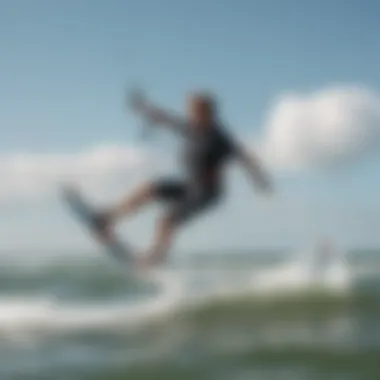
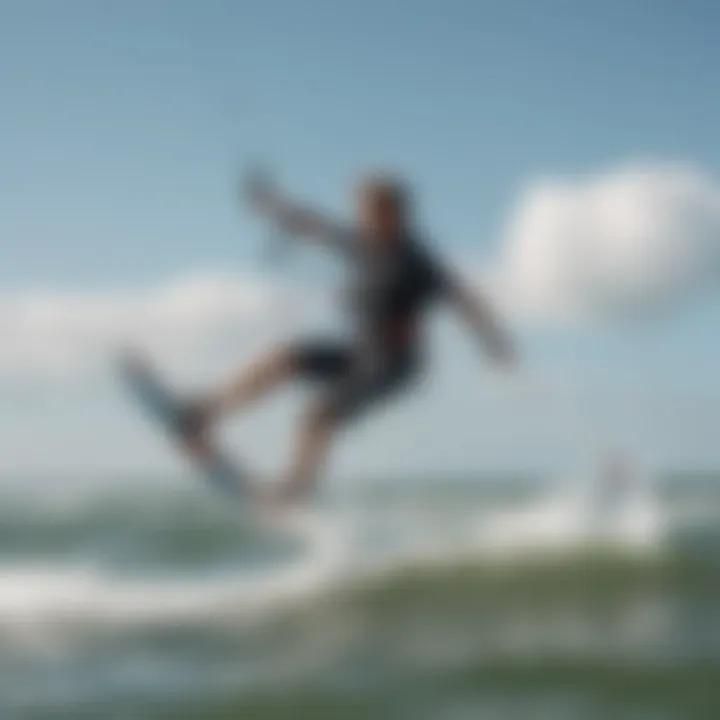
Intro
Kitesurfing has rapidly gained popularity as an exhilarating sport, merging elements of surfing, paragliding, and windsurfing. It offers a unique experience of slicing through the waves with a kite pulling you across the water, and Charleston, South Carolina, stands out as an excellent location for those wishing to dive into this thrilling pastime. It boasts ideal wind conditions, stunning beaches, and a supportive kitesurfing community.
This article delves into the world of kitesurfing lessons provided in Charleston, outlining everything from choosing the right instructor to understanding the necessary gear. Aspiring kitesurfers will find valuable insights into both beginner-friendly and advanced options, aiming to enhance skills and confidence while riding the winds.
Kitesurfing presents a gateway to adventure, and learning it in Charleston adds flavor thanks to its rich scenery and vibrant lifestyle. Whether it's your first time fumbling with a kite, or you're polishing your tricks, this comprehensive guide aims to equip you with essential knowledge and practical tips. Let's take the plunge into the essentials of kitesurfing lessons in Charleston.
Preamble to Kitesurfing
Kitesurfing is more than just a thrilling sport; it's a blend of art, science, and an invitation to commune with nature on the water. This article aims to peel back the layers of kitesurfing, especially in the picturesque settings of Charleston, SC. By diving into the nuances of the sport, prospective kitesurfers, both novices and seasoned practitioners, can discover not only the mechanics but also the emotional and physical benefits of engaging with this dynamic water activity.
Understanding kitesurfing involves considering various elements, from the technical skills needed to maneuver the kite and board to the environmental factors that can affect one's ability to ride. Charleston serves as an ideal backdrop for learning, thanks to its favorable winds and stunning coastlines. Moreover, kitesurfing offers a community aspect that can foster connections and friendships, paving the way for shared experiences and growth.
Understanding the Sport
Kitesurfing combines elements of surfing, windsurfing, and paragliding. Riders harness the power of the wind with a large kite, which propels them across the water on a board, creating the exhilarating experience of gliding over waves. The fundamental components include the kite, the bar and lines that control the kite, and the board itself.
Kites are designed in various shapes and sizes to suit different wind conditions and rider preferences. Understanding the characteristics of your kite is essential, as it dictates how you’ll navigate the water.
An integral part of kitesurfing is learning about wind patterns and how they affect your ride. Knowing the differences between onshore and offshore winds, for example, can influence your safety and enjoyment levels while out on the water. Getting a grasp of the wind's behavior and learning how to read it can markedly improve your kitesurfing skills.
Why Choose Kitesurfing
Kitesurfing may seem daunting at first, but it offers unmatched rewards that far outweigh the initial learning curve. Here are a few compelling reasons to consider this sport:
- Physical Fitness: Kitesurfing is an excellent way to build strength and endurance. Maneuvering a kite and riding requires a good workout, benefiting various muscle groups.
- Mental Escape: The focus required for kitesurfing can clear your mind, making it a form of meditation on the water. Many kitesurfers find it a perfect way to unwind and escape the pressures of daily life.
- Adventure and Excitement: For those with a thirst for adventure, kitesurfing delivers thrill like no other. The rush of speeding across water, coupled with the ability to launch into the air and perform tricks, is an experience unlike any other.
- Community Connection: Getting involved in kitesurfing can lead to friendships with fellow enthusiasts. Local clubs, coastal meet-ups, and events foster community and camaraderie among kiteboarders.
"Kitesurfing is more than just a sport; it's a passion that draws you into its thrilling embrace."
Whether you're drawn by the thrill, the physical activity, or the sense of community, kitesurfing in Charleston offers a well-rounded experience that can benefit many aspects of life.
The Appeal of Charleston for Kitesurfers
When it comes to kitesurfing, having the right location can make all the difference. Charleston, South Carolina, offers a unique blend of geographical features and climate conditions that cater well to this adrenaline-fueled water sport. For both novices and seasoned kiteboarders, understanding why Charleston is a prime destination for kitesurfing can significantly enhance the learning experience.
Geographical Advantages
Charleston is nestled along the coast, surrounded by a variety of waterways—from the open ocean to serene bays and estuaries. This geographical diversity provides kitesurfers with multiple venues to explore, whether they prefer flat water or waves.
- Access to Multiple Spots: With popular kitesurfing locations like Folly Beach, IOP, and Sullivan's Island, enthusiasts can choose between different styles of riding and varying conditions. Each spot offers its own vibe and challenges, which helps keep the experience fresh.
- Wind Conditions: The orientation of the coastline in relation to prevailing winds allows for consistent wind patterns, ideal for kitesurfing. Frequent northeast winds, along with thermal winds during the warmer months, create a reliable kiting environment.
- Safety and Space: The expansive beaches and spacious waters provide ample room for beginners to practice without the worry of overcrowding or obstacles, making it easier to learn the ropes.
Local Climate Conditions
Charleston boasts a subtropical climate that further enhances its appeal for kitesurfers throughout much of the year.
- Mild Winters: Even during winter months, temperatures tend to stay mild, rarely dropping below 40°F. This means that kitesurfers can take advantage of decent wind conditions without battling icy waters, unlike in many northern states.
- Warm Summers: Summer sees temperatures typically ranging from 75°F to 90°F, with warm winds that are perfect for kiting. While heat can sometimes affect performance, the steady ocean breezes provide a refreshing counterbalance.
- Consistent Winds: The wind here is both dependable and variable—meaning kitesurfers can enjoy a range of conditions, including steadier winds for beginners and stronger gusts for advanced riders seeking a thrill.
"With its combination of geography and climate, Charleston emerges not just as a scenic spot but a veritable playground for kitesurfing enthusiasts."
By understanding these key elements, one can truly appreciate why Charleston stands out as an alluring destination for kitesurfing. The geographic layout ensures ample opportunity without compromising safety, while the local climate remains conducive to both instruction and recreation.
In essence, Charleston provides a solid foundation for anyone looking to dive into the exhilarating world of kitesurfing.
Choosing the Right Kitesurfing Lessons
Choosing the right kitesurfing lessons is critical for anyone keen on embracing the thrill of this water sport. A well-structured lesson can lay the foundation for not just skill development, but also instill safety practices and build confidence on the board. With Charleston being a prime destination, the availability of tailored lessons is a boon for both beginners and seasoned surfers alike.
Key elements to consider include the qualifications of instructors, the lesson format, and the pace at which one learns. The right instructor can make all the difference, helping students navigate the nuances of the sport while ensuring they grasp the core principles of kitesurfing effectively. Moreover, various lesson formats cater to the diverse preferences and learning styles of individuals, whether they thrive in a one-on-one setting, prefer group dynamics, or enjoy the flexibility of online resources.
Identifying Qualified Instructors
When it comes to kitesurfing, a qualified instructor can spell the difference between a rewarding experience and one fraught with frustration. It’s not just about being an excellent surfer; instructors must be adept in teaching techniques that cater to all skill levels. They should possess certifications from recognized organizations, such as the International Kiteboarding Organization, to validate their proficiency.


Furthermore, a good instructor engages with their students, adapting the lessons to their specific learning curves. They should prioritize safety while encouraging learners to push their limits. Personal recommendations, reviews from former students, and social media profiles often provide insights into their teaching effectiveness. Look for those who have a knack for making complex concepts simple, as this approach can significantly enhance the learning curve and engagement.
Available Lesson Formats
Kitesurfing lessons come in a variety of formats, each with its unique flavor and appeal. Selecting the appropriate format can influence not only your learning but also your enjoyment of the sport.
Private Lessons
Private lessons are often deemed the gold standard for those seeking personalized training. One significant aspect of private lessons is the focus they allow instructors to place on the student’s individual needs. This tailored approach can result in quicker skill acquisition as instructors can adjust the pace and style of teaching to resonate with the learner.
The major advantage of private lessons lies in the one-on-one attention, giving students plenty of opportunities to ask questions, practice techniques, and receive immediate feedback. However, it can be pricier than group sessions, so potential learners must weigh their budget against their desire for personalized instruction.
Group Lessons
Group lessons create an energetic environment, making them popular among many kitesurfing enthusiasts. The social aspect of learning alongside peers provides motivation and camaraderie that can be incredibly rewarding. These lessons often foster bonds with fellow aspiring kitesurfers, making the learning process more enjoyable.
A key characteristic of group lessons is their affordability, as costs are typically lower when split among participants. However, the downside may be limited individual time with the instructor. Some individuals might find it tougher to absorb techniques in a more crowded setting, leading to varied learning speeds.
Online Tutorials
In today’s digital world, online tutorials have carved out a niche in kitesurfing education. One particular aspect of these tutorials is their flexibility. Learners can progress at their own pace, replay sections as needed, and access a plethora of resources without geographical constraints.
The unique feature of online tutorials lies in their wealth of content; from video demonstrations to detailed articles, they cater to diverse learning preferences. However, relying solely on online resources can lack the hands-on guidance crucial for mastering practical skills, making it ideal to complement them with actual lessons.
"The choice of lesson format can shape your kitesurfing journey, so consider your goals, learning style, and budget carefully."
In summation, selecting the right kitesurfing lessons significantly influences the overall experience and skill acquisition. Each format—private, group, or online—brings its own set of advantages and challenges, tailored to cater to different learners. An informed decision not only accelerates the learning curve but also enriches the enjoyment of kitesurfing in beautiful Charleston.
Essential Equipment for Kitesurfing
When it comes to kitesurfing, diving into the sport without the right gear is like trying to fish without a hook. The essential equipment for kitesurfing serves as the backbone of your experience, ensuring both safety and performance while you ride the waves. Choosing wisely can mean the difference between soaring through the air with fluidity and struggling to stay afloat. The following sections will break down the core components that every kitesurfer needs to consider.
Kite Types and Sizes
Kites come in various shapes and sizes, each designed for different wind conditions and skill levels. It’s vital to understand how to choose the right kite to maximize your time on the water. Generally, kites fall into a few categories:
- C-kites: Known for their high performance and excellent unhooked tricks, these kites are preferred by advanced riders.
- Bow kites: Offering more power and stability, these are ideal for beginners due to their consistent flying characteristics.
- Delta kites: They combine features of both C-kites and bow kites, providing versatility across conditions.
The size of the kite also matters significantly. A larger kite pulls harder, which can amplify the thrill but may be overwhelming for beginners. Conversely, smaller kites are easier to handle and are suitable for lighter wind conditions. It’s often recommended by seasoned kitesurfers to consult with instructors or rental shops to find the most suitable size for both your weight and experience level.
Board Selection
Selecting the right board is another cornerstone of your kitesurfing setup. Boards come in several types, primarily distinguished by their shape and materials:
- Directional boards: Great for surfing on waves, these boards allow for smooth turns and gravity-defying moves.
- Twin-tip boards: These are the most common for beginners, as they can ride in either direction, making them versatile and user-friendly.
- Foil boards: For those looking to try something new, foil boards let you ride above the water, providing a unique experience.
When choosing a board, pay attention to the length and width as well. Longer boards offer more stability, while shorter boards are more agile. The choice should align with your riding style, the conditions you'll be facing, and, of course, your personal comfort.
Safety Gear Requirements
Safety should be your top priority in any water sport, and kitesurfing is no exception. Having the right safety gear can significantly reduce risks and ensure that you enjoy your time on the water. Here are some essentials:
- Harness: This bears the brunt of the power from the kite, so a comfortable and fitted harness is crucial.
- Impact vest: Though not always mandatory, this gear adds a layer of protection against falls and impacts.
- Helmet: Wearing a helmet is especially advisable for beginners or those practicing tricks, safeguarding your head from unexpected mishaps.
- Leash: A kite leash is essential; it keeps the kite connected to you, even if you lose grip.
Investing in good safety gear can save you from unnecessary injuries and allow for a more enjoyable experience. It’s always worth remembering that a solid setup today leads to a safe and thrilling ride tomorrow.
Always prioritize safety – it's better to have gear and not need it than need it and not have it.
Barriers to Entry in Kitesurfing
Understanding the barriers to entry in kitesurfing is crucial for newcomers and seasoned enthusiasts alike. It is more than just picking up a kite and heading to the water. This section delves into the common obstacles that can hinder one's journey into this exhilarating sport. By addressing the various challenges—whether they relate to equipment accessibility or environmental conditions—prospective kitesurfers can better prepare themselves for their experiences.
Access to Equipment
When starting out in kitesurfing, the first hurdle is often access to the appropriate equipment. Many might find themselves grappling with the decision of whether to rent or purchase gear. For those on a budget, renting can be a lifesaver, allowing individuals to test different types of kites and boards without breaking the bank. However, this comes with limitations regarding availability and often, the quality of gear options. It’s not always easy to find rental shops stocked with top-of-the-line equipment, especially during peak seasons.
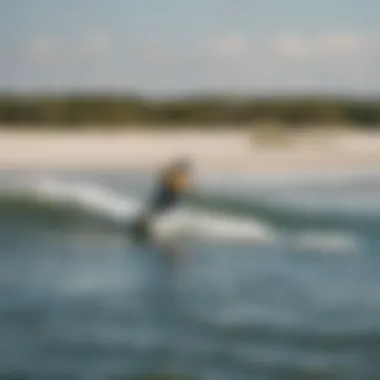
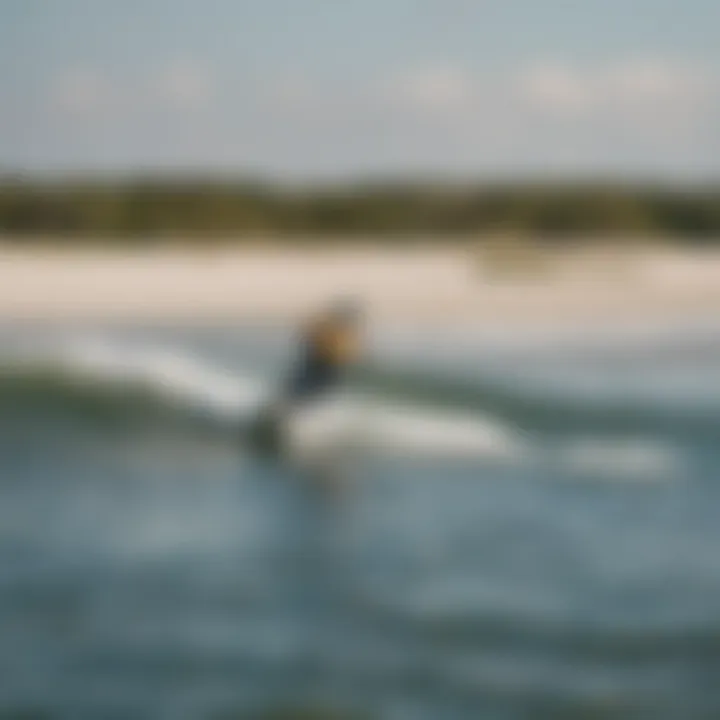
On the other side, buying equipment brings its own set of challenges. Kitesurfing gear isn't cheap, and new learners may feel overwhelmed by the sheer variety of brands and models. Many shops offer packages that bundle everything together, but it’s essential for buyers to do their homework. Understanding the right kite size for specific wind conditions, alongside selecting a comfortable and suitable board, can make a significant difference in the learning experience.
With a burgeoning kitesurfing community in Charleston, local instructors often have recommendations for reputable shops, taking the guesswork out of gear shopping. Ultimately, budgeting and prioritizing your needs can help in tackling the equipment barrier effectively.
Environmental Challenges
Kitesurfing takes its name from the value of wind and water, two elements that can also serve as significant barriers. Environmental conditions in Charleston can be fickle; therefore, aspiring kitesurfers need to become knowledgeable about the local climate and tides. Strong winds can be exhilarating but also unsafe for beginners. Learning to read the wind and water conditions is not just useful; it’s essential for safety and enjoyment.
The tide schedule plays a critical role in accessibility to launch points. Some spots in and around Charleston might appear ideal at one moment, only to be turned into a shallow flat land at low tide. Understanding these patterns is vital for timing your kitesurfing sessions. Additionally, both beginners and experienced riders must be aware of potential hazards in the water. From other watercraft to sporadic buoys, remaining vigilant is important.
The kitesurfing community is known for being helpful; finding a mentor or joining local groups can provide first-hand insights into the best practices. Utilizing forums like reddit.com can also yield valuable tips about face-palm situations and solutions from fellow enthusiasts.
**"The thrill is real, but so are the precautions."
Navigating Local Regulations and Safety
When it comes to kitesurfing, especially in a vibrant locale like Charleston, understanding the local regulations and safety measures is paramount. This ensures that not only do you enjoy the sport safely, but also that you are abiding by the laws that govern it. Ignoring regulations can lead to complications, ranging from fines to unsafe practices on the water. Therefore, being well-versed in permits, licensing, and safety protocols contributes significantly to a fulfilling kitesurfing experience in Charleston.
Permits and Licensing
In Charleston, engaging in kitesurfing may require certain permits depending on where you intend to practice. Local authorities may have specific regulations about where kitesurfing is allowed or restricted. Understanding these rules can keep you from landing in hot water—literally and figuratively.
It is advisable to check with local parks or coastal management offices about any required permits. Some areas may also have designated kitesurfing zones, where you can safely enjoy your sport without worrying about interference from other water activities or non-compliance with regulations.
Here are key points concerning permits and licensing:
- Check Local Regulations: Local ordinances can vary greatly. Researching beforehand can save you time and hassle.
- Designated Areas: Utilize only areas that are designated for kitesurfing to avoid potential fines or unsafe conditions.
- Insurance: While not always mandatory, obtaining insurance that covers kitesurfing can protect you against accidents.
"Before hitting the water, it's worth your while to ensure you’re in the clear with local regulations."
Safety Protocols
Safety in kitesurfing cannot be overstated. With winds whipping and waves crashing, understanding safety protocols is crucial for both beginners and seasoned riders alike. Life jackets, helmets, and leash systems are just the start. Being prepared is your best defense against potential dangers.
Here are some pivotal safety practices to adhere to while kitesurfing in Charleston:
- Know Your Equipment: Familiarize yourself with your gear. Ensure everything is in good condition before you head out.
- Weather Awareness: Understand the weather conditions and how they affect water and wind. High winds can turn even the best of days into a disaster.
- Buddy System: Always kite with a friend when possible. It's wise to have someone out there with you for assistance.
- Communication: Use hand signals or radio equipment to communicate, especially in busy kiting spots.
- Safety Zones: Respect areas designated as safe zones for others, including swimmers and other watercraft.
By observing these safety measures in conjunction with the necessary permits and licensing, you ensure that your kitesurfing experience in Charleston is not only enjoyable but also secure. Observing local regulations and applying safety protocols allows you, and others, to kitesurf in a respectful and cooperative environment.
Community and Networking Opportunities
Kitesurfing isn’t just about the thrill of gliding across the water or the wind whipping through your hair; it's equally about the connections you make along the way. The community of kitesurfing in Charleston is vibrant, providing a network of support, shared experiences, and camaraderie among enthusiasts and professionals alike. This community aspect adds depth to the learning experience and opens up a plethora of opportunities for both newcomers and seasoned riders.
Participation in local kitesurfing clubs or events can serve as a cornerstone for building relationships. Whether you’re seeking tips from veterans or simply sharing a laugh over a miscalculated jump, the bonds formed in this unique environment can become some of the most rewarding aspects of the sport. Finding a club not only places you in the center of kitesurfing action but also helps create a safety net where you can learn together.
Local Kitesurfing Clubs
In Charleston, several kitesurfing clubs welcome both beginners and experienced surfers. These clubs often offer structured lessons, and clinics, and even social gatherings to foster a sense of belonging. For example, the Charleston Kiteboarding Club stands out as a hub for enthusiasts, frequently organizing meetups at popular local spots such as Folly Beach and the Isle of Palms.
Participating in club activities can enhance your learning experience in numerous ways:
- Mentorship Opportunities: Pairing up with seasoned riders provides invaluable insights into technique and safety.
- Shared Equipment: Some clubs lend gear, which can be a budget-friendly option for newcomers.
- Networking: Meeting fellow kitesurfers opens doors to trips and events that you might not have heard about otherwise.
Events and Competitions
Events and competitions play a huge role in solidifying the kitesurfing community. These gatherings pull together participants from all skill levels, allowing for an exchange of techniques and experiences. In Charleston, seasonal events are commonplace, showcasing local talent while fostering a competitive spirit.
Competitions can range from local challenges to larger tournaments that attract riders from across the southeast. Even if you're not competing, attending these gatherings can be rewarding. You'll witness diverse styles, get inspired by breathtaking maneuvers, and enjoy the kinship that follows the spirit of competition.
Some key advantages of attending events include:
- Skill Development: Watching skilled riders can inspire you to push your limits.
- Community Engagement: Mingle with others who share your passion, creating lasting friendships.
- Sponsorships: For those serious about kitesurfing, local competitions can sometimes lead to sponsorships and recognition.
Overall, the social fabric interwoven within the kitesurfing culture in Charleston enhances the overall experience for both newcomers and experienced riders. You’re not just learning to kitesurf; you’re becoming a part of a community that thrives on excitement, shared challenges, and joyous moments on the water.

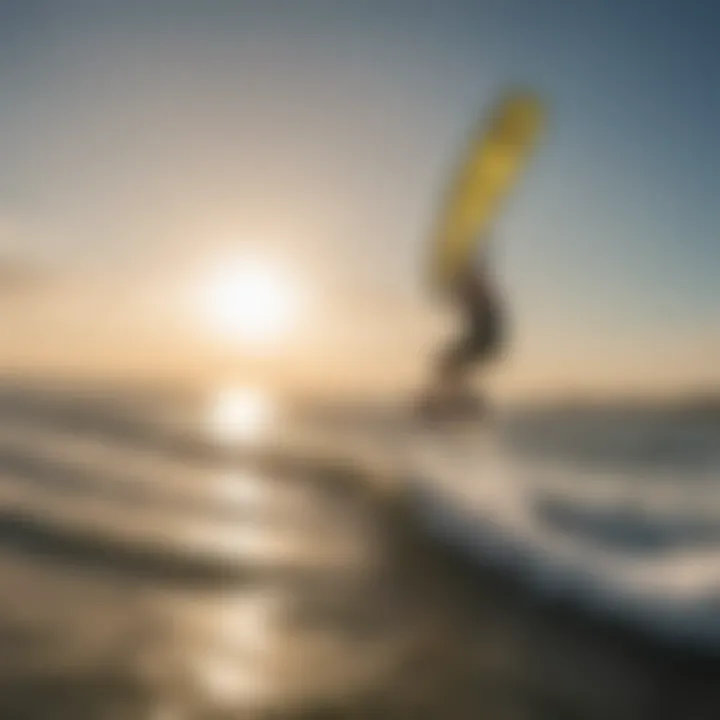
"It’s this blend of adrenaline and community that frames the perfect kitesurfing journey, creating not only great riders but lasting friendships."
Whether you immerse yourself into a local club or participate in an event, the community aspect enriches your kitesurfing experience considerably.
Kitesurfing Destinations Nearby
Kitesurfing doesn't hinge solely on lessons and equipment; the destinations where you can launch and land your kite significantly affect your progress and enjoyment. Nearby locations to Charleston provide an array of environments that cater to different skill levels and preferences. Each spot boasts its unique charm and challenges, making the exploration of these areas essential for anyone serious about honing their kitesurfing skills.
Being well-informed about local kiteboarding spots enhances your overall experience. Whether you're training or just enjoying a day on the water, understanding the unique characteristics of each destination helps you assess conditions like wind direction, wave height, and safety measures, ensuring a smoother ride. Here is a deeper look into some of the notable sites around Charleston:
Popular Local Spots
Charleston itself has several well-regarded kitesurfing locations, but it's important to explore spots a short drive away as well. Here are a few local favorites:
- Folly Beach: Known for its vibrant atmosphere and reliable winds. Ideal for beginners and seasoned riders alike. The expansive sandy stretches allow for plenty of space to take off and land.
- ** Isle of Palms**: This location’s shallow waters make it perfect for those just starting out. It fosters a relaxed setting, which is excellent for practicing technique without the anxiety of big waves.
- Kiawah Island: Offers a more exclusive experience, with beautiful marshland views. The conditions can vary, providing an opportunity for kitesurfers to challenge themselves further in less crowded waters.
- Sullivan’s Island: Similar to Isle of Palms, it's suitable for beginners but also serves as a playground for advanced kitesurfers looking to catch some bigger swell on good days.
Visiting these sites can expose you to different wind patterns and water conditions, often leading to unexpected learning opportunities. Each location enhances your understanding of the sport and gives you the chance to connect with other kitesurfing enthusiasts.
Traveling Beyond Charleston
While Charleston has plenty of kiting potential, exploring further afield can be equally rewarding. States like North Carolina and Florida offer remarkable destinations worth considering:
- Cape Hatteras, North Carolina: Famed for its steady winds and varied conditions, it's a magnet for professional kitesurfers and novices alike. The large flatwater areas and wave spots allow for diverse experiences.
- South Padre Island, Texas: A little further to trek, but the combination of warm weather and consistent winds draws kitesurfers from all around the country across the seasons.
- Miami, Florida: The Biscayne Bay presents superb flatwater riding and is famous for its vibrant nightlife. It's a bustling hub for kiting, especially during events and competitions.
Traveling to these locations not only broadens your skills but helps you build relationships with kitesurfers outside your usual circle. > Amidst the winds and waters, every kitesurfing location holds unique opportunities to grow and connect with others who share the passion.
In summary, the nearby destinations and those beyond Charleston offer kitesurfers vast experiences that can deepen their relationship with the sport. These settings can turn an ordinary practice session into an exciting adventure.
Tips for Progressing in Kitesurfing
Kitesurfing can often feel like trying to juggle flaming torches while balancing on a tightrope. It’s thrilling, but without the right guidance and strategy, it can quickly become overwhelming. This section aims to provide practical advice on how learners can effectively progress in their kitesurfing journey. Setting clear goals and practicing the right techniques can pave the way to increasing one's skills, confidence, and enjoyment in the sport.
Goal Setting for Learners
To kick things off, it’s crucial for each kitesurfing beginner to set tangible goals. Think of it like having a compass while sailing; it keeps you on course. Whether you're eyeing to master the basics or aiming for more advanced moves, having clear objectives helps you channel your focus. Here are some elements to consider when setting goals:
- Specificity: Rather than saying, "I want to become a better kitesurfer," you might want to say, "I want to learn how to do a jump within three months."
- Measurable Progress: Keep track of your learning journey. This could be in the form of practicing a technique a set number of times each week.
- Achievable Targets: Ensure the goals are within reach. It's great to dream big, but don't set yourself up for failure from the get-go.
- Timeline: Give yourself deadlines. For example, "I will attempt my first jump in four lessons."
- Reflect and Adjust: Regularly assess your progress. If something’s not working, don’t hesitate to amend your approach to fit your learning style better.
"Setting clear goals in kitesurfing is like having a map; it charts the course to your success."
Practicing Techniques
Once you’ve set your sights on clear goals, the next logical step is to practice effectively. Here’s where the rubber meets the road, as they say. Practicing the right techniques not only builds competence but also fosters confidence. Here are some best practices:
- Consistent Sessions: Try to hit the water regularly. The more time you spend on your board, the more comfortable you’ll become.
- Focus on Basics: Don’t rush into advanced tricks. Mastering the fundamentals prepares you for more complex maneuvers.
- Incorporate Video Analysis: If possible, record yourself. Watching your technique can help you identify what needs tweaking.
- Seek Feedback: Engage with instructors or experienced kitesurfers. Their insights can make a world of difference.
- Work with a Buddy: Practicing with a fellow beginner or an experienced kiteboarder can add an element of fun while allowing you to learn from each other.
For kiteboarders looking to refine their skills in Charleston, utilizing local conditions can also play a significant role in progression. Observing how the tide, wind, and environment affect kiting can not only aid in mastering the sport but also enhance overall experiences.
By focusing on thoughtful goal-setting and dedicated practice, aspiring kitesurfers can carve out a path to simultaneously improve their skills and enjoyment, ultimately making the sport more fulfilling.
The Future of Kitesurfing in Charleston
As the tides shift in the realm of water sports, kitesurfing finds a promising foothold in Charleston, South Carolina. The ability to harness strong winds and beautiful coastal views makes this location not only attractive for newcomers but also a potential hotspot for the sport’s future. This section delves into what lies ahead for kitesurfing in this charming city, touching on the emerging trends and the anticipated growth of the sport.
Emerging Trends
Kitesurfing is constantly evolving, and Charleston is no exception. A few key trends stand out:
- Technological Advancements: The equipment being used today is nothing like what was available even a few years back. Modern kites are lighter and more durable, allowing for a more exhilarating yet safe experience. New materials and manufacturing processes are pushing the boundaries of performance and safety.
- Environmental Awareness: As more enthusiasts take to the waves, there's an increasing emphasis on eco-friendly practices. Beach clean-up initiatives and sustainable kite materials are gaining traction. Kitesurfers are beginning to recognize their role in keeping Charleston’s natural beauty intact.
- Diversity of Styles: Different kiteboarding styles are emerging, from freestyle and wave riding to foil kiting. Instructors are adapting their lessons to cover these various approaches, attracting a wider range of participants.
"The future of kitesurfing in Charleston is as bright as the vibrant sunsets over the Atlantic. Awareness of its environmental impact and a focus on innovation are key to sustainable growth."
These trends not only indicate a vibrant future but also reflect a community that’s willing to adapt and grow, pushing the sport into new realms of possibility.
Potential Growth of the Sport
The future potential growth of kitesurfing in Charleston hinges on several factors:
- Increased Participation: As more people discover the thrill of kitesurfing, with local schools and clinics making it accessible to beginners, there’s potential for a surge in kitesurfers in the region. It becomes a social activity, uniting individuals with a shared passion.
- Tourism Boost: With Charleston’s picturesque beaches and favorable winds, the draw for tourism could rise. This influx of visitors looking to kitesurf can stimulate local economies. Kitesurfing festivals or competitions could be organized, turning the city into a destination for kiteboarders.
- Community Support: A strong local community can be the backbone for any sport’s prosperity. With clubs and social media groups growing in popularity, there’s not only a network for support but also avenues for collaboration on events and educational programs.
- Youth Engagement: Introducing kitesurfing programs in schools can ignite interest among younger generations. By sparking that young enthusiasm, kitesurfing stands to establish itself as a lifelong sport for many, ensuring its legacy in Charleston’s beaches.
As kitesurfing continues to gain traction and evolves alongside environmental concerns and community engagement, the future for it in Charleston looks promising. With a blend of innovation and tradition, the city is poised to become a beacon for kitesurfers far and wide.







